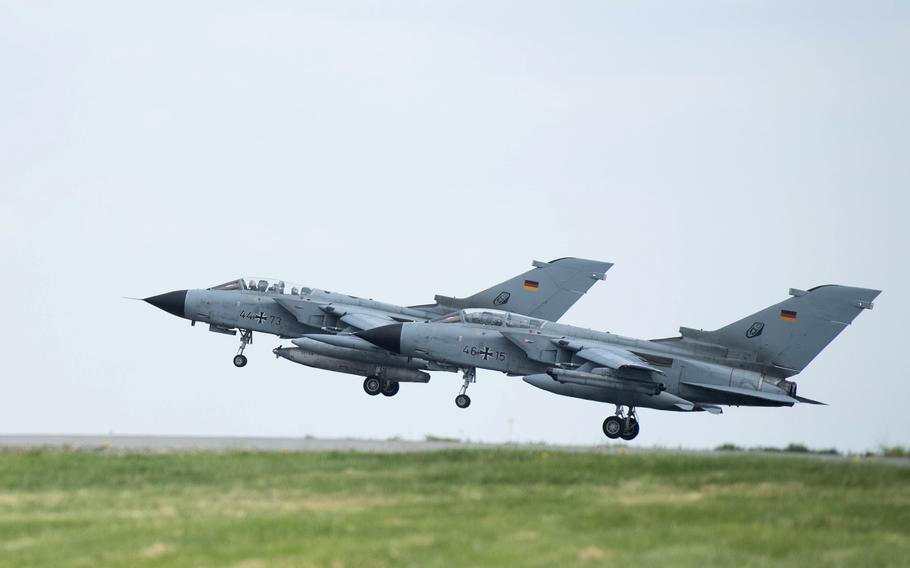
Two German air force Tornadoes take off at Buechel Air Base in Germany on May 7, 2022. About 20 U.S. nuclear warheads are believed to be stored at the base. The Heritage Foundation said in a report issued last week that some U.S. nuclear bombs positioned in Europe should be relocated to Poland. (Warren Spearman Jr./U.S. Air Force)
Some U.S. nuclear bombs positioned in European countries such as Germany, Italy and the Netherlands should be relocated to Poland, which wants in on NATO’s nuclear burden-sharing mission, a new report argues.
While stationing such weapons in Western Europe made sense during the Cold War, adding Poland to the mix would adapt the alliance’s nuclear strategy to current threats, the conservative Heritage Foundation said in its report, issued last week.
NATO’s eastward enlargement following the collapse of the Soviet Union means that allied fighter planes carrying nuclear gravity bombs would have farther to travel to reach enemy targets.
“If such distances require a fighter bomber to conduct an aerial refueling before reaching a target, both the fighter bomber and the refueler could be vulnerable to enemy long-range air defenses,” the report authors said.
The think tank’s report comes amid a public push by Poland to be incorporated into NATO’s nuclear burden sharing mission. In June, Prime Minister Mateusz Morawiecki announced that Warsaw was seeking to join the initiative, which would require allied approval.
“Due to the fact that Russia intends to site tactical nuclear weapons in Belarus, we are all the more asking the whole of NATO about taking part in the nuclear sharing program,” Morawiecki said in a June 30 statement. “We don’t want to sit with our arms crossed while (Russian President Vladimir) Putin escalates a different type of threat.”
It’s still unclear whether the U.S. is willing to give the idea serious consideration. After Poland’s request, U.S. National Security Council spokesman John Kirby told reporters “I have nothing to say about any conversations of this type.”
Any such changes to NATO’s nuclear arrangement would ratchet up tensions with Russia, which would consider nuclear weapons in Poland escalatory.
But Russia’s own nuclear saber rattling and apparent plan to position some of its nuclear arsenal in Belarus justify a countermove by NATO, the Heritage Foundation said.
Doing so would “assure those NATO allies closest to Russia that the arsenal remains credible and effective; and better dissuade Russian aggression by increasing the relevance of the nuclear deterrent,” the report said.
The NATO nuclear mission involves U.S. tactical bombs that allied fighter pilots would deliver if a conventional conflict turned into an atomic one.
Tactical weapons deliver a smaller explosive yield than more advanced strategic nuclear weapons, which are delivered via long-range bombers, land-based intercontinental ballistic missiles and submarine-launched missiles.
In theory, tactical nuclear weapons could be used for a more limited strike, resulting in less widespread radioactive fallout than their strategic counterparts produce.
While the U.S. does not publicly discuss where its tactical bombs are stored in Europe, watchdog groups have reported that roughly 100 are stored at six bases in five NATO member countries: Belgium, Germany, Italy, the Netherlands and Turkey. A NATO document inadvertently released and then deleted in 2019 listed the same locations.
Besides deterring Russian nuclear aggression, the NATO burden-sharing arrangement is intended to assure allies that the U.S. nuclear guarantee is credible and that the strike mission is a responsibility shouldered by the alliance as a whole.
“This is all done, in part, by providing a visible, geographic distribution and demonstration of NATO’s nuclear capabilities,” the Heritage Foundation report said, arguing that bringing those capabilities closer to Russia bolsters alliance credibility.
The presence of U.S. nuclear weapons has been a point of political contention in some of the countries that host them.
For example, a 2020 YouGov poll found that 74% of Italians, 58% of Dutch and 83% of Germans wanted nuclear weapons off their soil.
While Russia’s full-scale invasion of Ukraine in 2022 may have softened that position, there is a long track record of anti-nuclear sentiment in those countries.
Should an ally in the future ask the United States to remove its nuclear weapons, having Poland in the mix would be a risk-mitigation measure, the report stated.